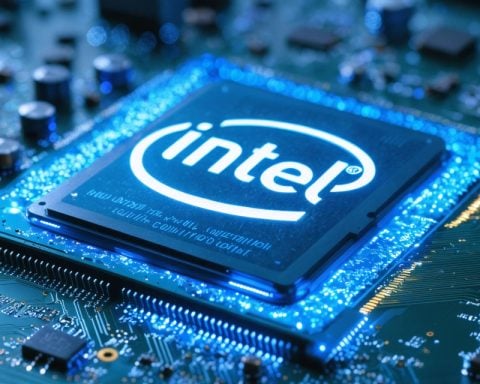- Apple’s growth prospects, especially in artificial intelligence, face mixed reactions from investors.
- The company retains high market value but struggles with slow revenue growth and limited AI breakthroughs.
- Apple’s high price-to-earnings ratio doesn’t align with its current innovation pace, presenting risks.
- Competitors like DeepSeek lead in AI innovation, offering cost-effective and efficient solutions.
- Analysts recommend exploring agile AI contenders, including software companies and tech adopters, for better returns.
- Focus is shifting to lesser-known companies that bring innovation outside the spotlight.
- The evolving AI landscape suggests potential for significant impact from unheralded players.
Apple, the tech titan celebrated for innovation and sleek design, now finds itself navigating choppy waters. Under the scrutinizing spotlight of investors, the company’s growth prospects, particularly in artificial intelligence, evoke mixed reactions. As Apple glides along its legacy rails, propelled more by brand allure than by technological breakthroughs, a question lingers: when will their next big leap land?
The once awe-inspiring leader faces fierce competition. Its revenue growth stagnates at a meager pace, a stark contrast to its towering market valuation. With a price-to-earnings ratio soaring above industry average, Apple juggles high expectations without matching momentum in AI advancements. Meanwhile, DeepSeek and other innovative forces worldwide sprint ahead, accelerating AI efficiencies and delivering cost-effective solutions.
Analysts and market watchers suggest looking beyond the giants of the industry. They’re turning their gaze toward the nimble contenders in the AI scene—software companies, utility firms, and other tech adopters who harness AI’s power with greater agility. According to some experts, hedging bets on these agile players could yield better returns. This shift in focus isn’t just about diversifying holdings; it reflects a belief in under-the-radar companies—a belief that innovation often flourishes outside the mainstream spotlight.
As Apple continues to command the stage, the real action may be unfolding backstage. Investors seeking substantial gains are wise to explore the untapped potential lying in the uncharted arenas of AI, where dynamic entrants reshape the landscape. The takeaway? Sometimes it’s the unheralded players who make the most significant impact, ushering in the next wave of technological evolution.
Will Apple Stay Ahead or Fall Behind? Uncovering Insights About Its AI Journey
How-To Steps & Life Hacks for Investing in AI
If you’re considering investing in AI, it’s crucial to evaluate both established giants like Apple and budding innovators. Follow these steps to make informed decisions:
1. Research the Market: Understand the current AI market landscape by analyzing industry reports from sources like Gartner or IDC.
2. Diversify Your Portfolio: Don’t just invest in major players. Consider emerging AI companies that show promise in delivering new solutions.
3. Monitor Trends: Keep an eye on technology trends, such as machine learning and data analytics, to identify potential high-growth areas.
4. Engage in Continuous Learning: Follow AI-focused publications and podcasts, like the Wired, for the latest insights and developments.
Real-World Use Cases of AI in Technology
Apple’s relatively slow movement in AI development doesn’t diminish the vast use cases AI offers:
– AI in Consumer Electronics: Companies are enhancing device functionality through machine learning algorithms, as seen in smart assistants like Siri or Google Assistant.
– Financial Sector: Firms use AI to predict market trends, automate trading, and improve customer service through chatbots.
Market Forecasts & Industry Trends
According to expert predictions, the AI industry is set to grow exponentially, with emerging trends focusing on:
– Personalization: AI-driven personalized experiences are the future, tailored to individual user preferences.
– Edge AI: Processing data on devices rather than centralized servers will become more prevalent, benefiting speed and privacy.
Reviews & Comparisons
Comparing Apple’s AI development with other tech companies like Google and Amazon can offer insights:
– Apple: Known for hardware innovation but slower in large-scale AI integration.
– Google: Leading in AI research and application, especially with its contributions to open-source projects like TensorFlow.
– Amazon: Excels in AI for cloud computing with AWS, offering tools for businesses to develop their own AI solutions.
Controversies & Limitations
Apple faces challenges in the AI domain:
– Privacy Concerns: Apple’s strong stance on privacy can sometimes limit the scope of data-driven AI innovations.
– Pace of Innovation: The company has been criticized for lagging behind in AI advancements compared to competitors.
Features, Specs & Pricing
While specific specs vary, Apple’s AI-driven technologies generally align with their premium pricing strategy, focusing on:
– Quality: High-quality, reliable hardware that integrates seamlessly with AI features.
– Ecosystem: Integrated with Apple’s suite of products, providing a unified user experience.
Security & Sustainability
Apple emphasizes:
– Data Privacy: Protecting user data during AI processing by employing privacy-preserving techniques.
– Sustainability: Committing to environmentally friendly practices in product development and lifecycle.
Insights & Predictions for Apple
Apple’s future in AI might pivot based on:
– Strategic Acquisitions: Acquiring smaller AI startups could bolster their AI capabilities.
– Innovation Focus: Prioritizing AI innovation rather than just brand strength to maintain market competitiveness.
Pros & Cons Overview
Pros:
– Brand strength and a loyal customer base.
– Commitment to privacy and seamless ecosystem integration.
Cons:
– Slower adaptation to rapid AI advancements.
– High competition pressure in the tech industry.
Actionable Recommendations
– Stay Informed: Regularly update your knowledge about AI trends and market changes.
– Diversify Investments: Look beyond established players to capture opportunities in smaller, innovative companies.
– Leverage AI Tools: Use AI tools and solutions to enhance productivity and personal efficiency.
Apple might still be a strong player, but savvy investors should be open to exploring untapped potential elsewhere. Stay agile in both investment strategies and technology adoption.


















